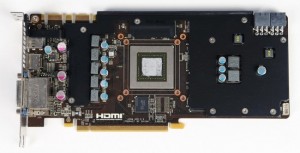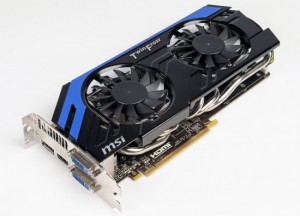The recently announced GeForce GTX 660 Ti has caused great interest of many users who want to get a powerful Graphics card. Indeed, the graphics card came out to be very attractive in terms of price / performance. However, for those who want to reach a top speed device, this solution is not very suitable. Reduced memory system bus and disabled ROP units do not allow to makes the most of GK104. Another thing is the first derivative of the flagship – GeForce GTX 670. While the NVIDIA reference cards in this series offer a simplified printed circuit board with a lightweight power subsystem graphics card manufacturers offer alternatives to the original cooler and overclocked. One striking example of this modernization is MSI N670 Power Edition 2GD5/OC.
Frequency formula forced version “OC” changed by the manufacturer. Basic MSI N670 Power Edition 2GD5/OC GPU frequency has been increased from 915 MHz to 1020 MHz, while the 2GB of GDDR5 memory running at 6008 MHz recommended.
Design and layout
MSI N670 Power Edition 2GD5/OC has used cooling system Twin Frozr IV makes good graphics card externally recognizable. The cooler is covered with decorative aluminium plate with bright blue insert. The basis of the cooler is a set of aluminium plates.
In this case, the heat transfer to the radiator helps cassette five plated heatpipes. Three of these six millimeters in diameter penetrate cooler in the central part, while the more massive 8mm conduct heat to remote areas radiator. To improve the contact between the heat pipe and heat sink, as well as plates, used soldering.
The whole structure is blown by two axial fans with a diameter of 80 mm. Blades Propeller Blade with a bevelled edge profile, according to the manufacturer, increase air flow.
Graphics card has an original circuit board, which is significantly different from the reference. It identical design applies to GeForce GTX 660 Ti Series Power Edition.
In this case of MSI N670 Power Edition 2GD5/OC, the power subsystem is built on semifaznoy scheme (5 +2), while in the chain of high-quality components are used, the relevant concepts Military Class III. A set of standard – tantalum capacitors, ferrite core and solid container
On the front side of the board is an aluminium plate, which is used for cooling assembly transistor and memory. Being attached to the interface panel, metal lath partly enhances the structural strength.
For additional power connection in MSI N670 Power Edition 2GD5/OC has two six-pin connectors located on the top edge of the card. Here is a pair of connectors for connecting multiple graphics cards in CrossFireX-configuration. Increase the clock speed of the chip, and increased need to increase the power subsystem TDP cards to 200 watts instead of 170 watts, typical for GeForce GTX 670 with the recommended formula and shortened the reference PCB. As for the recommendations to the power unit, in this case, when you create a PC with quad-core processor, it is advisable to use the PSU from 550 Tues.

On the mounting bracket has four interface connectors – a pair of DVI (DVI-I and DVI-D), as well as full-length HDMI and DisplayPort. About a quarter of the lattice panel is the cooling system. However, given the orientation of the radiator fins, the decision is not a convention it really helps to remove part of the hot air out of a PC.
Trim
The bundle is nothing extraordinary, it is typical for devices of this level – Quick Start booklet, user’s manual, CD with drivers and utilities MSI Afterburner, and a couple of adapters from Molex to six-pin power connector and a DVI to VGA.
In
Modifications used Twin Frozr IV came just right for video card. Outdoor bench chip temperature rose only to 30 degrees, while rotating with a frequency of 1050-1080 r / min fans run very quietly. Under load, the GPU temperature reached 71 degrees, and turns the fan increases to 2300-2350 r / min. As for the temperature characteristics, it is about 10-12 degrees cooler than the reference model, running at the recommended frequency. Decent results for MSI N670 Power Edition 2GD5/OC, especially when you consider that at nominal frequency 1020 MHz chip, thanks to GPU Boost, often increased to 1215 MHz. During the graphical utility FurMark torture CPU temperature rose only to 73 degrees, but in this case, of course, triggered a defense mechanism – the working frequency of the GPU does not exceed 1084 MHz.
Dust Removal technology became constant companion of the last cards from MSI. At boot time, within 30 seconds the fans are running in reverse, thus blowing inevitably collects dust on the blades and the radiator fins. In this case, there is a certain nuance of this mechanism. The fact that the rotation in the opposite direction is the fan increases speed to maximum. On the one hand the generated flow maximizes clean design elements from dust, on the other – at this point the noise and higher comfort level cannot disable this feature.
Like other series Graphics Power Edition, the model considered supports Triple Overvoltage. Original development of MSI enables programmatically adjusts voltages, not only on the GPU, also on the memory and bus.
Acceleration
Despite the fact that the graphics chip was originally working on overclocking, plus of course the video card, but the potential for overclocking on this MSI N670 Power Edition 2GD5/OC is far from exhausted. After increasing the parameter Power Limit to 114%, and the voltage on the chip by 40 mV, it was able to raise the base rate of the core to 1140 MHz. Further, the game load GPU Boost dynamically accelerated chip to 1309-1322 MHz. Dispersing the adapters with GPU Boost functions is important not to overdo it. In this case, mindlessly shoot sliders power adjustment and stress – not a good idea. Technology dynamic frequency of the GPU requires a more delicate approach, with gradual increments voltage and clock frequency. Only in this case, you can configure the video card for the maximum performance.
As for building memory, the chips from Hynix worked beautifully. Increasing by 30 mV voltage circuits, achieved stable operation at 7420 MHz (1855 MHz), which is 23.5% higher than the base value. Increasing the capacity of the memory system on the platform with GK104 – a sure way to get a good performance increase in high-resolution modes and graphics quality settings.
Note that after the dissolution of the increase of supply voltage, temperature of the chip under load increased to 73 C. The potential with good, because in order to keep this temperature GK104, operating at frequencies 1300 + MHz, it took only a slight increase of fan speed – up to about 2400-2450 / min.
Performance
With the possible GeForce GTX 670 we know quite well, because in this case we are rather interested in the increase in productivity, which provides factory overclocked video card, as well as the number of frames / c, which brings an additional crossing of the adapter.
Overclocking brings original MSI N670 Power Edition 2GD5/OC extra 3-8% performance. Forcing manually increases the gap between ordinary GeForce GTX 670 to 14-23%. Moreover, we note that MSI is using firmware with extended range of GPU Boost. Frequency difference (delta) is higher here than in the reference model. For the experiment, reducing the core clock speed of the reporting adapter to the recommended 915 MHz, it received about 1110 MHz after the dynamic acceleration, while the chip reference GeForce GTX 670 graphics cards after functions at 1040-1080 MHz.
After additional overclocking MSI N670 Power Edition 2GD5/OC is fully able to compete with the flagship operating normally. It is not only showing similar results, but often even ahead of GeForce GTX 680 by 5-10%. The high frequency of the chip / memory impact on productivity and in many cases can make up the difference in the number of computer processors.
Results
MSI N670 Power Edition 2GD5/OC – an interesting option for users who understand the tasks for which you can use the powerful graphics card. At a price of just over $ 400, the adapter provides the performance matches that of the single-GPU flagship – GeForce GTX 680. Enhanced component base and efficient cooling system will, without prejudice to the stability of a video card overclocking not only during the experiments and test sessions, but also on an ongoing basis. Tattered accelerator with decent margin performance – the smart choice for gaming aesthetes who appreciate the speed and placing maximum demands for quality graphics, but it can count your money.
Pros:
+ Full-time factory overclocked
+ Effective cooling system
+ Good potential for additional overclock
+ After a further boost performance at the level GeForce GTX 680
+ Original PCB with enhanced power system
Cons:
– Elevated levels of noise during operation Dust Removal
This was all regarding the MSI N670 Power Edition 2GD5/OC graphics card whose price is around $400.
